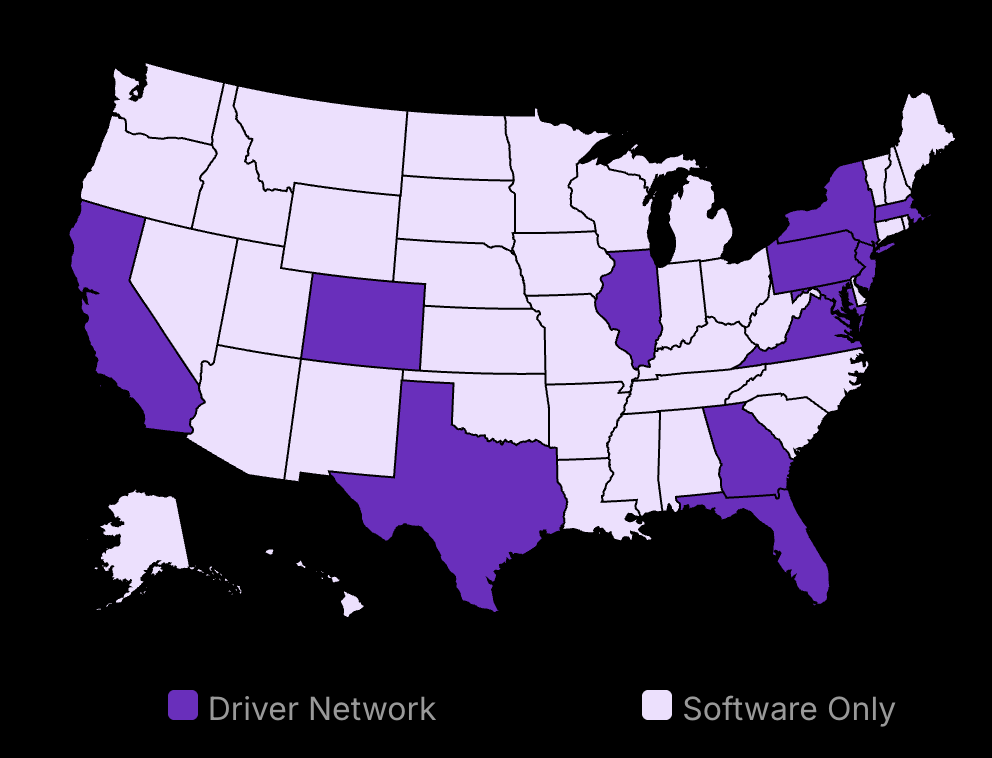Many small businesses fail due to cash flow problems, not lack of profit. But what are the important cash flow metrics for small businesses that can keep your business afloat?
In this piece, we’ll break down the top metrics backed by real data. You’ll get clear answers on how to measure cash flow and what benchmarks to aim for. Learn which metrics for small businesses are essential to keep an eye on to ensure your venture thrives.
We’ll dive into concepts like operating cash flow and its role in daily operations. Plus, find practical tips to manage cash flow effectively.
Get ready for a no-nonsense guide that makes financial health easier to handle.

Lower your delivery costs by 23%
How we reduce costs:
- No delivery vehicle expenses
- Optimized local routes
- Pay-per-delivery model
- Average 23% delivery cost reduction
Understanding Cash Flow Metrics for Small Businesses: Basic Concepts and Definitions
What Is Cash Flow?
Cash flow is the total amount of money being transferred into and out of a business. It’s not just about profits; it’s about how well a company manages its cash in the short term. Cash flow can often give a clearer picture of financial health than the balance sheet because it shows the real-time situation. A business may be profitable on paper but still have cash flow problems. For small businesses, this is especially important because they often operate with tighter margins and rely heavily on day-to-day money coming in.
For small business owners, understanding cash flow means knowing whether they can pay employees, and suppliers, and cover other expenses on time. It’s about ensuring that the money available aligns with the money owed. For a complete picture of your financial health, uncover which small business performance metrics you should monitor regularly.
What is a Good Cash Flow for a Small Business?
Having a positive cash flow is vital. It means a business’s incoming cash is greater than its outgoing cash. Positive cash flow allows businesses to settle debts, reinvest, return money to shareholders, pay expenses, and provide a buffer against future financial challenges.
Indicators of positive or negative cash flow can include a pattern of increasing cash balance over time noncash expenses and more cash entering the business than leaving. Monitoring these trends can serve as an early warning system for potential financial issues.
Industry benchmarks can vary by sector. For instance, retail businesses usually have net credit sales and have tighter cash flow cycles compared to service industries.
Analyzing and understanding these aspects of the company’s cash flow statement can be a game-changer for small businesses striving to thrive in a competitive marketplace.
Prepare for a deeper dive into key metrics that can help in assessing and enhancing your cash flow situation in the following sections.
Essential Cash Flow Metrics Every Small Business Should Track
Operating Cash Flow
Understanding and managing your operating cash flow is foundational for keeping your business running smoothly.
Calculate Operating Cash Flow:
-
Gather Financial Documents: Collect all income statements and balance sheets. These documents provide the data needed for calculations.
-
Identify Operating Revenues: Find the total sales revenue as shown on your income statement.
-
Identify Operating Expenses: List all operating expenses, including cost of goods sold, wages, rent, and utilities.
-
Perform Calculation: Subtract total operating expenses from total operating revenues.
-
Double-check Figures: Compare your result with previous periods to ensure accuracy and identify any inconsistencies.
With this calculation, determine how well your business generates free cash flow from its core operations.
Role in Daily Operations:
Operating cash flow plays a vital role in day-to-day financial activities. It tells you if the business can generate enough cash to maintain and expand operations. It also a cash flow coverage ratio helps identify liquidity shortages before they become a problem. When monitoring this metric, consider setting thresholds to alert you when cash flow falls below a certain level.
Cash Flow from Investing Activities
Tracking cash flow from investing activities can be key performance indicators that guide long-term strategic decisions.
Calculate Cash Flow from Investing Activities:
-
List Investment Transactions: Collect information on all transactions related to buying or selling fixed assets, such as equipment or real estate.
-
Include Non-Current Assets: Assess investments in long-term assets, such as stocks or bonds.
-
Calculate Net Cash Flow: Add up total cash inflows from selling assets and subtract total cash outflows from asset purchases.
Importance in Long-Term Planning
This metric allows owners to evaluate the impact of investment decisions on the business’s operating cash flow margin and reserves. Efficiently managing and investing cash flow and planning investments ensures businesses can fund future projects, improve infrastructure, and grow strategically.
Cash Flow from Financing Activities
Insight into cash flows from financing activities can optimize financial planning and satisfy obligations.
How to Track Cash Flow from Financing Activities
-
Identify Financing Sources: Include loans received, equity raised, and any other financing sources.
-
Document Repayments and Distributions: Add any cash paid out for debt repayments, dividends, or stock buybacks.
-
Compile Net Financing Cash Flow: Calculate by subtracting total cash outflows for repayments and distributions from total inflows from financing.
Keeping a detailed track of these transactions ensures accurate financial statements and records.
Examine Its Impact
Understanding cash flows from financing activities helps assess the company’s ability to repay debts and the impact on cash reserves. Monitoring this can safeguard against financial instability caused by over-leveraging or mismanaging repayments.
Cash Flow Management Tips for Small Business Owners
Monitoring and Reporting Regularly
Importance of Consistent Tracking
Keeping a close eye on cash flow is crucial for business success. Nearly 82% of small businesses fail due to cash flow problems, highlighting the need for regular monitoring. Pay attention to both incoming and outgoing to understand cash flow metrics, across all business activities. Setting a fixed schedule for reviewing cash flow – weekly, bi-weekly, or monthly – ensures you won’t miss any unexpected fluctuations. Regular check-ups help preempt problems before they become major issues.
Tools and Templates That Help
Using the right tools can make tracking much easier. Consider accounting software like QuickBooks or Xero. These help automate calculations and provide real-time insights. Set up templates in spreadsheets if you prefer a manual approach. You can create customized reports tailored to your specific business needs. This brings clarity to your finances.
-
Select Your Tracking Tool: Choose between digital tools or manual spreadsheets based on your comfort level.
-
Schedule Regular Reviews: Set up reminders to ensure reports are checked regularly.
-
Analyze Trends: Look for patterns or outliers that might need attention.
A practical setup could be a dashboard on your computer that shows cash flow changes daily or weekly. Integrating these with your bank accounts can save time and reduce errors.
How to Implement Cash Flow Forecasting Techniques
Steps to Project Cash Flow
Forecasting your cash flow involves predicting how much cash will flow into and out of your business over a given period. Here’s a systematic approach:
-
Gather Past Financial Data: Collect historical cash flow statements for at least the past 12 months. This serves as the baseline.
-
Identify Regular Income and Expenses: Categorize recurring sources of income and significant expenses.
-
Predict Future Costs: Estimate costs for upcoming projects or purchases. Last year’s numbers can guide you here.
-
Assess Seasonal Changes: Consider peaks and valleys in sales. This often affects cash flow.
-
Develop the Forecast Model: Using your data, forecast cash flow every month for at least a year.
-
Review and Adjust: Regularly revisit and adjust the projection as real data becomes available.
Using forecast templates can streamline this process. They help maintain consistency and make updates simple.
Common Mistakes to Avoid
Be aware of frequent pitfalls in forecasting. Overestimating net income while underestimating expenses is common. This can lead to a false sense of security. Avoid relying solely on static forecasts. Business conditions change, and your forecast should too.
-
Be Realistic: Base projections on actual data, not optimistic assumptions.
-
Include Buffer Funds: Set aside cash beyond projected needs to cover surprises.
-
Regular Updates: Update your forecast frequently, at least every quarter.
These practices make agile responses to unforeseen financial challenges possible. A survey shows that managing cash flow effectively helps in customer acquisition costs and reducing business failures.
With consistent monitoring and effective forecasting, cash flow becomes a tool for growth rather than a potential disaster. This sets the stage for understanding deeper financial and other cash flow metrics, and cash flow margin which are critical in making informed business decisions.
Financial Ratios for Small Businesses: Deep Dive
Current Ratio
The current ratio is a key financial metric that measures liquidity. It shows a company’s ability to cover its short-term debts with short-term assets. A ratio above 1 means more assets than liabilities, suggesting that the company has a buffer.
For small businesses, maintaining a healthy current ratio ensures financial flexibility. It allows for meeting urgent expenses without scrambling for funds. Identify and monitor essential small business revenue growth indicators to effectively scale your business and maintain financial health.
The connection between the current ratio and cash flow is clear. If a business has ample liquidity, unexpected costs won’t drain funds. It’s a foundational metric that should be reviewed regularly, especially since small businesses with weekly or monthly financial reviews show a 75-95% success rate, compared to just 25% for annual reviews.
Quick Ratio
The quick ratio refines the current ratio further. It excludes inventory, focusing on liquid assets. This makes it a sharper tool for assessing immediate financial health. A quick ratio of 1 or more typically indicates an ability to cover current liabilities without depending on inventory liquidation.
Calculating the quick ratio involves subtracting inventory from current assets before dividing by current liabilities. This gives a picture of financial readiness without relying on potentially unsellable stock.
For small business owners, the quick ratio acts like a financial pulse check. It’s crucial for quick assessments, especially useful for businesses experiencing fluctuating inventory levels. It aids in spotting liquidity issues early, ensuring that cash flow remains unstrapped during crises. Keeping this ratio in check can prevent operational disruptions and support seamless financial operations.
Debt-to-Equity Ratio
Managing balance sheets and investments requires a deep understanding of the debt-to-equity ratio. This ratio compares total liabilities against shareholders’ equity, offering insights into a business’s financial structure and leverage.
A low debt-to-equity ratio signifies stability, reducing risk for potential investors. Aswath Damodaran mentions, “A low debt-to-equity ratio indicates a more stable financial position and reduced risk for potential buyers.” For small businesses, managing this ratio well aligns with sustainable business growth and prudent risk management.
There are debates around acceptable debt levels. Some argue that higher debt can spur faster growth, but it also brings more risk. Small businesses need to find a balance aligning with their strategic goals. Books like “The Essentials of Corporate Finance” by Ross, Westerfield, and Jordan provide more depth and case studies on managing this ratio, making it a recommended read for those wishing to investigate further.
Net Profit Margin
Net profit margin stands for gross profit, out as a measure of profitability. It reveals how much profit is generated from total revenue after deducting all expenses. This figure is crucial not just for understanding current performance, but also for setting future pricing strategies and cost-cutting measures. Learn the benchmarks for healthy net profit margins in small enterprises and strategies to enhance them amid market competition.
Josh Kaufman points out, “Net profit margin provides insight into a company’s ability to manage its expenses and generate profits.” For small businesses, healthy net margins can be a sign of efficient cost management and effective business strategies. Keeping an eye here can inform decision-making, particularly concerning revenue reinvestment and resource allocation.
Balancing a solid net profit margin often requires strategic financial oversight. Readership can expand their knowledge by diving into texts like “Financial Intelligence” by Karen Berman and Joe Knight. Such resources break down complex financial subjects, offering context and applications relevant to small businesses.
Asset Turnover Ratio
The asset turnover ratio illustrates how effectively a company harnesses its assets to generate revenue. For asset-heavy businesses, this ratio indicates operational efficiency and utilization rates. It calculates sales divided by average assets during a period. Enhance operational efficiency by understanding the impact of asset turnover ratios on small businesses. Discover how this metric can optimize asset utilization and drive revenue growth.
A higher ratio suggests efficient asset use, maximizing production with existing resources. Conversely, a lower ratio might indicate underutilization, hinting at potential asset waste. For small businesses, optimizing this ratio of capital expenditures can lead to improved cash flow and better investment returns.
However, the asset turnover ratio must be considered alongside other metrics, to get a complete financial picture. Critics argue that on its own, it might not reflect profitability accurately, as higher ratios sometimes come from low-margin industries. For a comprehensive understanding of accounts payable turnover alone, pairing this with studies from journals like “The Journal of Finance” can provide both a theoretical and practical perspective on efficiently managing a company’s accounts payable turnover and assets.
Improving Business Liquidity: Strategies and Insights
Short-Term Loan Management
Evaluating Different Loan Options
Evaluating short-term loans requires careful consideration of interest rates, fees, and repayment terms. Options range from traditional bank loans, which often have lower rates but stricter qualifications, to online lenders offering quick cash but at higher costs. This choice impacts not just immediate liquidity but the business’s financial health. Understanding loan structures, fixed versus variable rates, and the potential for refinance is crucial. Resources like “The Banker’s Guide to Loan Strategies” provide insights into choosing the right loan type.
Repayment Planning and Effects on Cash Flow
Repayment planning for loans should align with cash inflows. Accelerated repayment can reduce interest costs but may strain liquidity if not managed well. On the flip side, extending repayment terms might ease short-term pressure but increase total costs. Balancing these options helps sustain a healthy cash flow. Monitoring and adjusting repayments aligned with cash forecasts can prevent liquidity crunches.
Efficient Inventory Management
Impact of Inventory Turnover on Liquidity
A fast inventory turnover enhances liquidity by converting stock into cash. Slow turnover ties up working capital and can lead to liquidity issues. Businesses must analyze turnover rates, balancing between overstocking and stockouts—just as precision is key in AI stock trading to optimize buy and sell decisions.
The book “Inventory Management Explained” discusses techniques for evaluating inventory efficiency and maximizing cash flow impacts. Boost your small business by generating more marketing qualified leads, as outlined in this detailed guide, to improve sales through efficient inventory management.
Tips for Optimizing Inventory Levels
Adopting a just-in-time inventory system reduces excess stock and frees cash. Forecasting demand accurately ensures right-sized orders. Regular inventory audits highlight slow-moving items, aiding decisions to discount or liquidate. Software tools that integrate inventory and sales data can provide real-time insights, enabling more agile inventory management.
Cost Control Measures
Importance of Cutting Unnecessary Expenses
Cost control is vital for liquidity. Unnecessary expenses, like unused subscriptions or excessive travel, deplete cash reserves. Regularly reviewing expenses against cash flow statements can uncover these leaks. Eliminating or reducing them boosts available operating cash flows. Prior studies, such as those discussed in “Effective Cost Management in Business,” highlight how cost-cutting directly relates to liquidity improvement.
Strategies for Maintaining Healthy Cash Flow
To maintain liquidity, businesses must monitor both fixed and variable expenses. Fixed costs, though constant, offer longer-term savings through renegotiation or restructuring. Variable costs, more flexible, can adapt to business volume. Identification of patterns where variable costs spike allows for strategic adjustments. Cash flow forecasting tools can model various expense scenarios, aiding proactive financial planning.
Wrapping It Up: Cash Flow Insights for Small Businesses
Knowing and tracking your cash flow metrics can keep your business on steady ground. Measuring operating cash flow, investing activities, and financing activities is crucial. Monitoring these allows small businesses to navigate financial challenges and plan for growth. Discover the techniques for calculating return on investment (ROI) for small businesses to guide your growth strategies and financial planning.
To make the most of these insights, start implementing regular cash flow reporting. Consider forecasting your cash flow to head off potential issues before they arise. Assess your current ratio and quick ratio to understand your liquidity position. Finally, sharpen your focus on inventory management and cost control.
Are you ready to improve your business’s financial health with these strategies? The power is in your hands. Enhancing your Average Order Value (AOV) can significantly influence your cash flow and profitability. Implementing exclusive tactics tailored for 2025, such as product bundling, personalized upselling, and subscription models, can drive higher sales per transaction and improve overall business performance. Learn more about boosting your average order value strategies to stay ahead in the competitive market.
Additionally, focusing on your average order value improvements can be a game-changer for your cash flow. By employing exclusive tactics for 2025 like curated product bundles, targeted upselling options, and subscription-based offers, small businesses can maximize revenue from existing customers. This strategic focus not only enhances profitability but also stabilizes cash inflows, helping you better manage your finances in an ever-evolving marketplace.






























